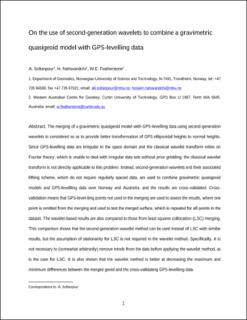| dc.contributor.author | Soltanpour, Ali | |
| dc.contributor.author | Nahavandchi, Hossein | |
| dc.contributor.author | Featherstone, Will | |
| dc.date.accessioned | 2023-04-12T12:50:32Z | |
| dc.date.available | 2023-04-12T12:50:32Z | |
| dc.date.created | 2006-06-22T14:42:59Z | |
| dc.date.issued | 2006 | |
| dc.identifier.citation | Journal of Geodesy. 2006, 80 (2), 82-93. | |
| dc.identifier.issn | 0949-7714 | |
| dc.identifier.uri | https://hdl.handle.net/11250/3062699 | |
| dc.description.abstract | The merging of a gravimetric quasigeoid model with GPS-levelling data using second-generation wavelets is considered so as to provide better transformation of GPS ellipsoidal heights to normal heights. Since GPS-levelling data are irregular in the space domain and the classical wavelet transform relies on Fourier theory, which is unable to deal with irregular data sets without prior gridding, the classical wavelet transform is not directly applicable to this problem. Instead, second-generation wavelets and their associated lifting scheme, which do not require regularly spaced data, are used to combine gravimetric quasigeoid models and GPS-levelling data over Norway and Australia, and the results are cross-validated. Cross-validation means that GPS-levelling points not used in the merging are used to assess the results, where one point is omitted from the merging and used to test the merged surface, which is repeated for all points in the dataset. The wavelet-based results are also compared to those from least squares collocation (LSC) merging. This comparison shows that the second-generation wavelet method can be used instead of LSC with similar results, but the assumption of stationarity for LSC is not required in the wavelet method. Specifically, it is not necessary to (somewhat arbitrarily) remove trends from the data before applying the wavelet method, as is the case for LSC. It is also shown that the wavelet method is better at decreasing the maximum and minimum differences between the merged geoid and the cross-validating GPS-levelling data. | |
| dc.description.abstract | The Use of Second-generation Wavelets to Combine a Gravimetric Quasigeoid Model with GPS-levelling Data | |
| dc.language.iso | eng | |
| dc.publisher | Springer | |
| dc.relation.uri | http://springerlink.metapress.com/(rq1h2djtufc3ut45ucyqe045)/app/home/contribution.asp?referrer=parent&backto=issue,2,5;journal,3,126;browsefavoritesresults,1:100435,2 | |
| dc.title | The Use of Second-generation Wavelets to Combine a Gravimetric Quasigeoid Model with GPS-levelling Data | |
| dc.title.alternative | The Use of Second-generation Wavelets to Combine a Gravimetric Quasigeoid Model with GPS-levelling Data | |
| dc.type | Peer reviewed | |
| dc.type | Journal article | |
| dc.description.version | acceptedVersion | |
| dc.rights.holder | © 2006 Springer Nature Switzerland AG. | |
| dc.source.pagenumber | 82-93 | |
| dc.source.volume | 80 | |
| dc.source.journal | Journal of Geodesy | |
| dc.source.issue | 2 | |
| dc.identifier.doi | 10.1007/s00190-006-0033-0 | |
| dc.identifier.cristin | 391501 | |
| cristin.ispublished | true | |
| cristin.fulltext | postprint | |
| cristin.qualitycode | 1 | |
